Enhanced Impact Strength of Ultra-High-Performance Concrete Using Steel Fiber and Polyurethane Grout Materials: A Comparative Study
Abstract
1. Introduction
2. Experimental Program
2.1. Materials
2.1.1. UHPC Materials
2.1.2. PUG Material
2.2. Specimen Preparation
2.3. Fabrication of Samples
2.4. Testing Method
2.4.1. Drop-Weight Impact Test
2.4.2. Digital Image Correlation Test
3. Results and Discussions
3.1. Failure Mode of U-Shaped UHPC
3.2. Impact Strength of UHPC
3.3. Ductility Index and Coefficient of Variation
4. Conclusions
- The U-shaped specimen facilitated the regulation of crack development. Reference UHPC experienced complete failure with a single drop, resulting in the test specimen being divided into two sections. In contrast, the UHPC containing fiber exhibited other web cracks alongside significant cracks.
- The brittleness of UHPC has been mitigated by adding SF and retrofitting techniques. The ability of U-shaped UHPC mixtures to withstand impact loads is enhanced with an increase in fiber volume fraction or PU grouting thickness.
- A thicker polyurethane (PU) overlay substantially improved the impact behavior of UHPC specimens by delaying cracking and enhancing failure loads. UHPC-10PU exhibited 107% and 147% higher first crack and failure impact strengths than UHPC-5PU, respectively. Remarkably, UHPC-15PU showed 363% and 449% higher first crack and failure strengths than UHPC5PU. Moreover, UHPC-5PU and UHPC-15PU demonstrated 400% and 33% superior impact performance over UHPC-1 and UHPC-3 at the first crack and failure stages, respectively.
- Adopting a U-shaped specimen geometry-controlled crack propagation to predetermined locations reduces variability in impact resistance data compared to the standard ACI 544 testing procedure. The coefficient of variation in this study ranged from 11.93% to 31%, lower than typical variations observed with the ACI 544 method.
Author Contributions
Funding
Data Availability Statement
Acknowledgments
Conflicts of Interest
References
- Wang, W.; Chouw, N. The behaviour of coconut fibre reinforced concrete (CFRC) under impact loading. Constr. Build. Mater. 2017, 134, 452–461. [Google Scholar] [CrossRef]
- Nili, M.; Afroughsabet, V. Combined effect of silica fume and steel fibers on the impact resistance and mechanical properties of concrete. Int. J. Impact Eng. 2010, 37, 879–886. [Google Scholar] [CrossRef]
- Murali, G.; Ramprasad, K. A feasibility of enhancing the impact strength of novel layered two stage fibrous concrete slabs. Eng. Struct. 2018, 175, 41–49. [Google Scholar] [CrossRef]
- Zhang, W.; Chen, S.; Zhang, N.; Zhou, Y. Low-velocity flexural impact response of steel fiber reinforced concrete subjected to freeze-thaw cycles in NaCl solution. Constr. Build. Mater. 2015, 101, 522–526. [Google Scholar] [CrossRef]
- Abid, S.R.; Shamkhi, M.S.; Mahdi, N.S.; Daek, Y.H. Hydro-abrasive resistance of engineered cementitious composites with PP and PVA fibers. Constr. Build. Mater. 2018, 187, 168–177. [Google Scholar] [CrossRef]
- Abid, S.R.; Hilo, A.N.; Daek, Y.H. Experimental tests on the underwater abrasion of Engineered Cementitious Composites. Constr. Build. Mater. 2018, 171, 779–792. [Google Scholar] [CrossRef]
- Wu, C.; Li, J.; Su, Y.D. Development of Ultra-High Performance Concrete against Blasts: From Materials to Structures; Woodhead Publishing: Sawston, UK, 2018. [Google Scholar]
- Su, Y.; Li, J.; Wu, C.; Wu, P.; Li, Z.-X. Effects of steel fibres on dynamic strength of UHPC. Constr. Build. Mater. 2016, 114, 708–718. [Google Scholar] [CrossRef]
- Chun, B.; Yoo, D.-Y. Hybrid effect of macro and micro steel fibers on the pullout and tensile behaviors of ultra-high-performance concrete. Compos. Part B Eng. 2019, 162, 344–360. [Google Scholar] [CrossRef]
- Zhang, B.; Feng, Y.; Xie, J.; He, J.; Yu, T.; Cai, C.; Huang, D. Compressive behaviours, splitting properties, and workability of lightweight cement concrete: The role of fibres. Constr. Build. Mater. 2022, 320, 126237. [Google Scholar] [CrossRef]
- Wang, J.; Xie, J.; Wang, Y.; Liu, Y.; Ding, Y. Rheological properties, compressive strength, hydration products and microstructure of seawater-mixed cement pastes. Cem. Concr. Compos. 2020, 114, 103770. [Google Scholar] [CrossRef]
- Abadi, P.M.S.; Baluch, A.H.; Sebaey, T.A.; Peeters, D.; Barzegar, M.; Lopes, C.S. Dispersed-ply design and optimization to improve the brittle flexural behaviour of composite laminates. Compos. Part A Appl. Sci. Manuf. 2023, 164, 107277. [Google Scholar] [CrossRef]
- Huang, L.; Su, L.; Xie, J.; Lu, Z.; Li, P.; Hu, R.; Yang, S. Dynamic splitting behaviour of ultra-high-performance concrete confined with carbon-fibre-reinforced polymer. Compos. Struct. 2022, 284, 115155. [Google Scholar] [CrossRef]
- Fan, D.; Yu, R.; Shui, Z.; Liu, K.; Feng, Y.; Wang, S.; Li, K.; Tan, J.; He, Y. A new development of eco-friendly Ultra-High performance concrete (UHPC): Towards efficient steel slag application and multi-objective optimization. Constr. Build. Mater. 2021, 306, 124913. [Google Scholar] [CrossRef]
- Bragov, A.M.; Petrov, Y.V.; Karihaloo, B.L.; Konstantinov, A.Y.; Lamzin, D.A.; Lomunov, A.K.; Smirnov, I.V. Dynamic strengths and toughness of an ultra high performance fibre reinforced concrete. Eng. Fract. Mech. 2013, 110, 477–488. [Google Scholar] [CrossRef]
- Su, Y.; Li, J.; Wu, C.; Wu, P.; Tao, M.; Li, X. Mesoscale study of steel fibre-reinforced ultra-high performance concrete under static and dynamic loads. Mater. Des. 2017, 116, 340–351. [Google Scholar] [CrossRef]
- Khosravani, M.R.; Silani, M.; Weinberg, K. Fracture studies of ultra-high performance concrete using dynamic Brazilian tests. Theor. Appl. Fract. Mech. 2018, 93, 302–310. [Google Scholar] [CrossRef]
- Pedram, Z.; Amir, M. Cyclic Behavior of Hybrid Columns Made of Ultra High Performance Concrete and Fiber Reinforced Polymers. J. Compos. Constr. 2012, 16, 91–99. [Google Scholar]
- Guo, Y.; Xie, J.; Xie, Z.; Zhong, J. Experimental study on compressive behavior of damaged normal-and high-strength concrete confined with CFRP laminates. Constr. Build. Mater. 2016, 107, 411–425. [Google Scholar] [CrossRef]
- Huang, L.; Xie, J.; Li, L.; Xu, B.; Huang, P.; Lu, Z. Compressive behaviour and modelling of CFRP-confined ultra-high performance concrete under cyclic loads. Constr. Build. Mater. 2021, 310, 124949. [Google Scholar] [CrossRef]
- Barr, B.; Baghli, A. A repeated drop-weight impact testing apparatus for concrete. Mag. Concr. Res. 1988, 40, 167–176. [Google Scholar] [CrossRef]
- Kishi, N.; Konno, H.; Ikeda, K.; Matsuoka, K.G. Prototype impact tests on ultimate impact resistance of PC rock-sheds. Int. J. Impact Eng. 2002, 27, 969–985. [Google Scholar] [CrossRef]
- Yıldırım, G.; Khiavi, F.E.; Anıl, Ö.; Şahin, O.; Şahmaran, M.; Erdem, R.T. Performance of engineered cementitious composites under drop-weight impact: Effect of different mixture parameters. Struct. Concr. 2020, 21, 1051–1070. [Google Scholar] [CrossRef]
- Madjlessi, N.; Cotsovos, D.M.; Moatamedi, M. Drop-weight testing of slender reinforced concrete beams. Struct. Concr. 2021, 22, 2070–2088. [Google Scholar] [CrossRef]
- Cao, Y.Y.Y.; Liu, G.; Brouwers, H.J.H.; Yu, Q. Enhancing the low-velocity impact resistance of ultra-high performance concrete by an optimized layered-structure concept. Compos. Part B Eng. 2020, 200, 108221. [Google Scholar] [CrossRef]
- Wu, Z.; Shi, C.; He, W.; Wang, D. Static and dynamic compressive properties of ultra-high performance concrete (UHPC) with hybrid steel fiber reinforcements. Cem. Concr. Compos. 2017, 79, 148–157. [Google Scholar] [CrossRef]
- Kamaruddin, Z.H.; Jumaidin, R.; Kamaruddin, Z.H.; Asyraf, M.R.M.; Razman, M.R.; Khan, T. Effect of Cymbopogan citratus Fibre on Physical and Impact Properties of Thermoplastic Cassava Starch/Palm Wax Composites. Polymers 2023, 15, 2364. [Google Scholar] [CrossRef] [PubMed]
- Song, P.S.; Wu, J.C.; Hwang, S.; Sheu, B.C. Statistical analysis of impact strength and strength reliability of steel–polypropylene hybrid fiber-reinforced concrete. Constr. Build. Mater. 2005, 19, 1–9. [Google Scholar] [CrossRef]
- Qi, H.J.; Boyce, M.C. Stress–strain behavior of thermoplastic polyurethanes. Mech. Mater. 2005, 37, 817–839. [Google Scholar] [CrossRef]
- Badr, A.; Ashour, A.F.; Platten, A.K. Statistical variations in impact resistance of polypropylene fibre-reinforced concrete. Int. J. Impact Eng. 2006, 32, 1907–1920. [Google Scholar] [CrossRef]
- ACI 544.2R-89; Measurement of Properties of Fiber Reinforced Concrete. American Concrete Institute: Farmington Hills, MI, USA, 1989; pp. 433–439.
- Abid, S.R.; Hussein, M.L.A.; Ali, S.H.; Kazem, A.F. Suggested modified testing techniques to the ACI 544-R repeated drop-weight impact test. Constr. Build. Mater. 2020, 244, 118321. [Google Scholar] [CrossRef]
- Haruna, S.I.; Zhu, H.; Jiang, W.; Shao, J. Evaluation of impact resistance properties of polyurethane-based polymer concrete for the repair of runway subjected to repeated drop-weight impact test. Constr. Build. Mater. 2021, 309, 125152. [Google Scholar] [CrossRef]
- Zhu, X.C.; Zhu, H.; Li, H.R. Drop-weight impact test on U-shape concrete specimens with statistical and regression analyses. Materials 2015, 8, 5877–5890. [Google Scholar] [CrossRef] [PubMed]
- GB/T 18046-2000; Ground Granulated Blast Furnace Slag Used for Cement and Concrete. Standard Press of China: Beijing, China, 2000.
- Haruna, S.I.; Zhu, H.; Ibrahim, Y.E.; Shao, J.; Adamu, M.; Farouk, A.I.B. Experimental and Statistical Analysis of U-Shaped Polyurethane-Based Polymer Concrete under Static and Impact Loads as a Repair Material. Buildings 2022, 12, 1986. [Google Scholar] [CrossRef]
- Haruna, S.I.; Zhu, H.; Shao, J. Experimental study, modeling, and reliability analysis of impact resistance of micro steel fiber-reinforced concrete modified with nano silica. Struct. Concr. 2022, 23, 1659–1674. [Google Scholar] [CrossRef]
- Al-shawafi, A.; Zhu, H.; Haruna, S.I.; Bo, Z.; Laqsum, S.A.; Borito, S.M. Experimental study and machine learning algorithms for evaluating the performance of U-shaped ultra-high performance reinforced fiber concrete under static and impact loads. J. Build. Eng. 2023, 70, 106389. [Google Scholar] [CrossRef]
- Al-shawafi, A.; Zhu, H.; Haruna, S.I.; Bo, Z.; Laqsum, S.A.; Borito, S.M. Impact resistance of ultra-high-performance concrete retrofitted with polyurethane grout material: Experimental investigation and statistical analysis. Structures 2023, 55, 185–200. [Google Scholar] [CrossRef]
- Prasad, N.; Murali, G. Exploring the impact performance of functionally-graded preplaced aggregate concrete incorporating steel and polypropylene fibres. J. Build. Eng. 2021, 35, 102077. [Google Scholar] [CrossRef]
- Abid, S.R.; Abdul-Hussein, M.L.; Ayoob, N.S.; Ali, S.H.; Kadhum, A.L. Repeated drop-weight impact tests on self-compacting concrete reinforced with micro-steel fiber. Heliyon 2020, 6, e03198. [Google Scholar] [CrossRef]
- Cao, H. Experimental investigation on the static and impact behaviors of basalt fiber-reinforced concrete. Open Civ. Eng. J. 2017, 11, 11–14. [Google Scholar] [CrossRef]
- Ding, Y.; Li, D.; Zhang, Y.; Azevedo, C. Experimental investigation on the composite effect of steel rebars and macro fibers on the impact behavior of high performance self-compacting concrete. Constr. Build. Mater. 2017, 136, 495–505. [Google Scholar] [CrossRef]
- Liu, Y.; Wei, Y. Drop-weight impact resistance of ultrahigh-performance concrete and the corresponding statistical analysis. J. Mater. Civ. Eng. 2022, 34, 4021409. [Google Scholar] [CrossRef]
- Mastali, M.; Dalvand, A. The impact resistance and mechanical properties of self-compacting concrete reinforced with recycled CFRP pieces. Compos. Part B Eng. 2016, 92, 360–376. [Google Scholar] [CrossRef]
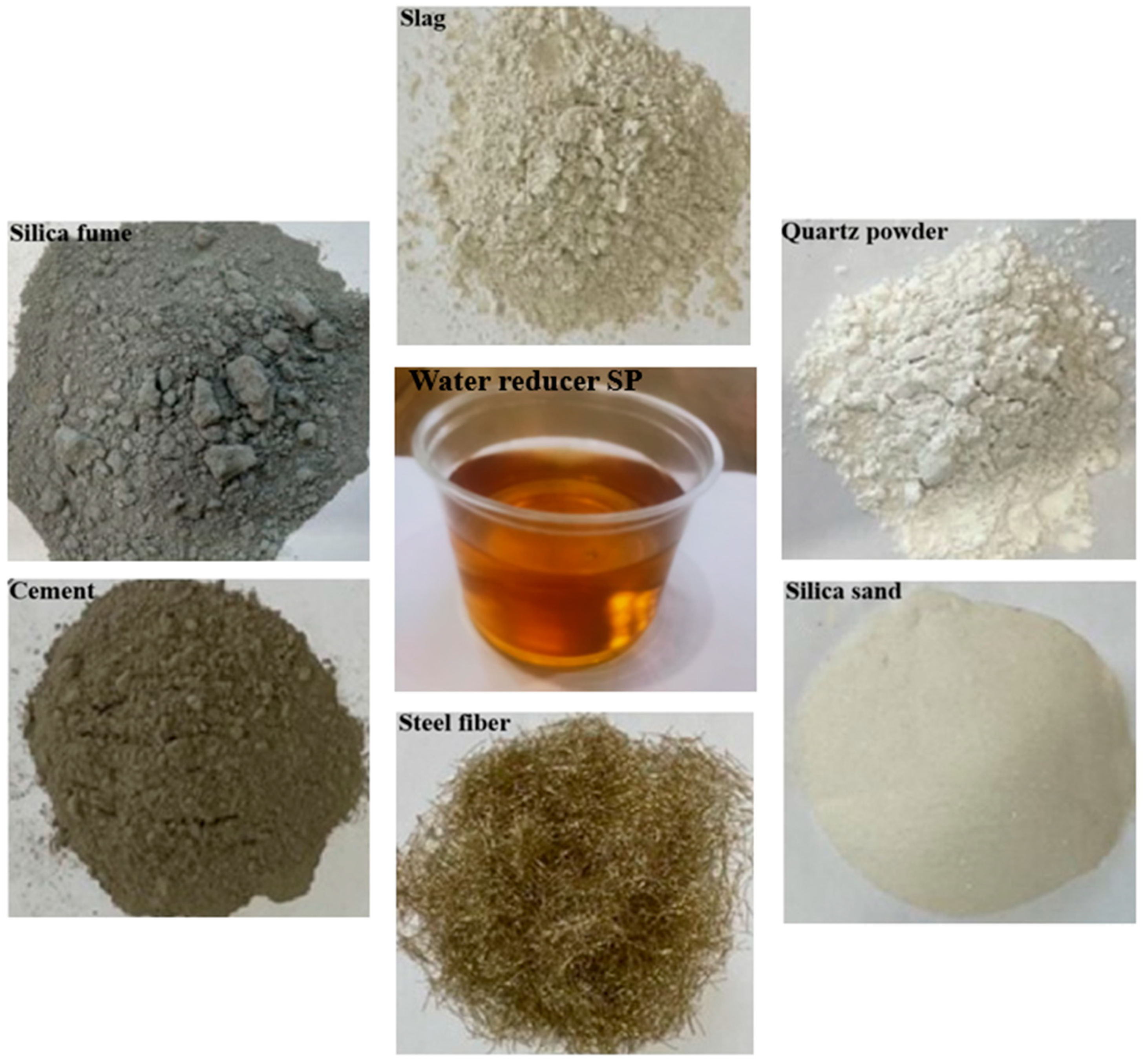
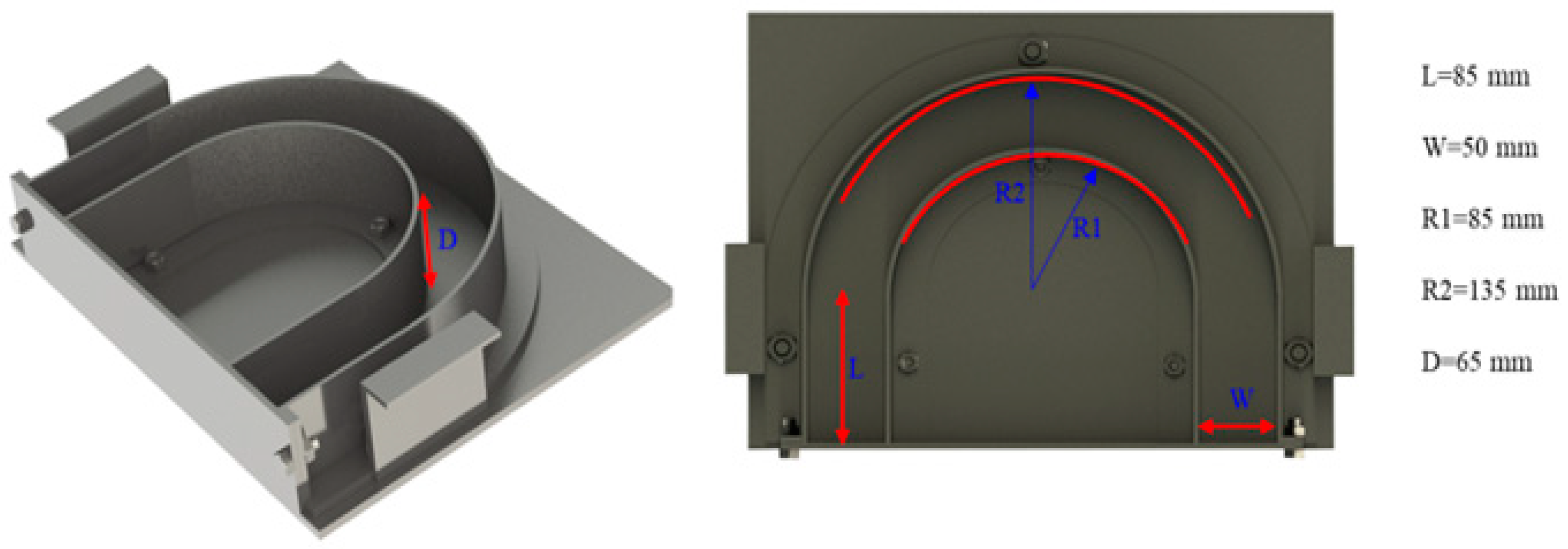
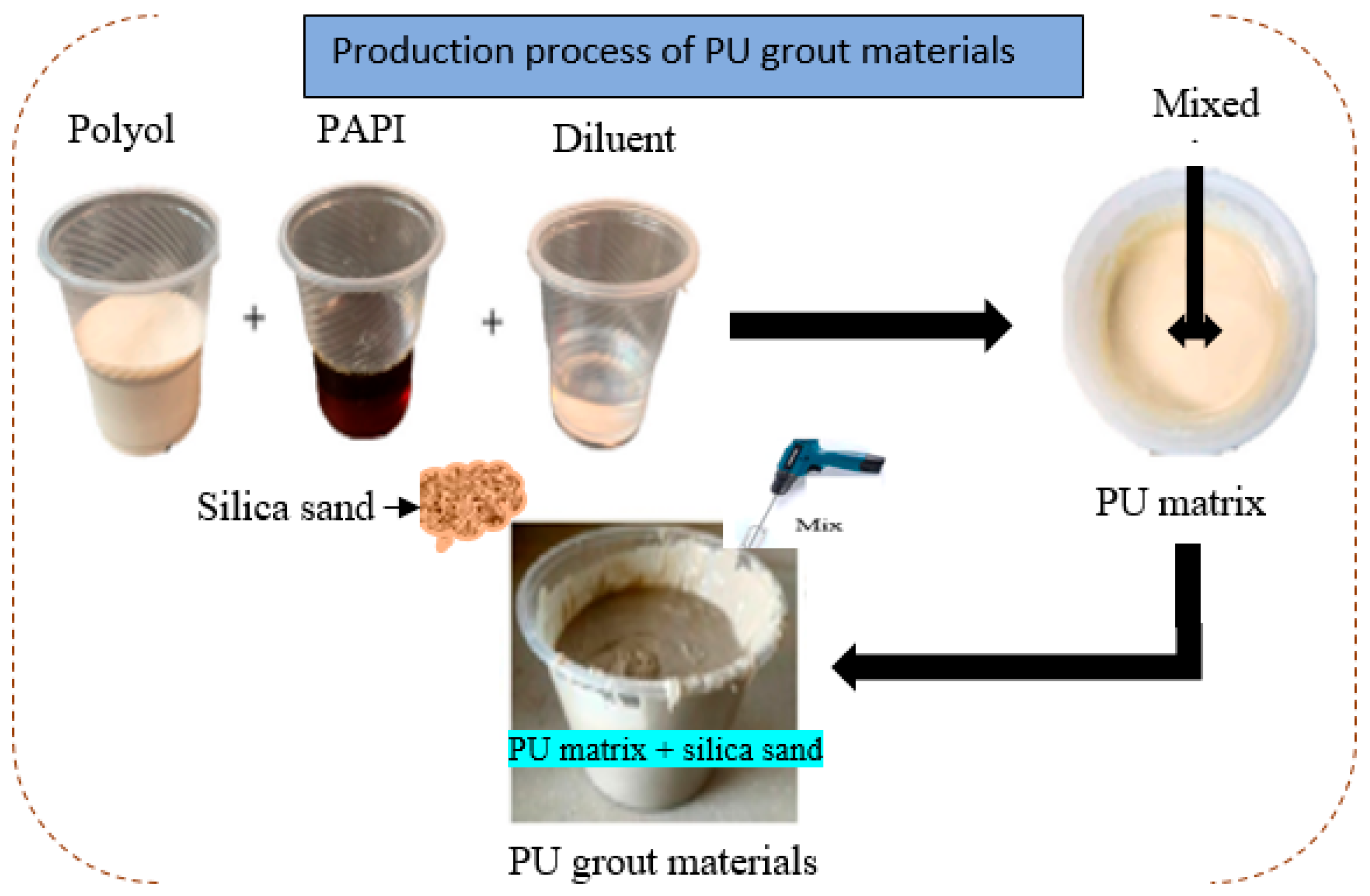
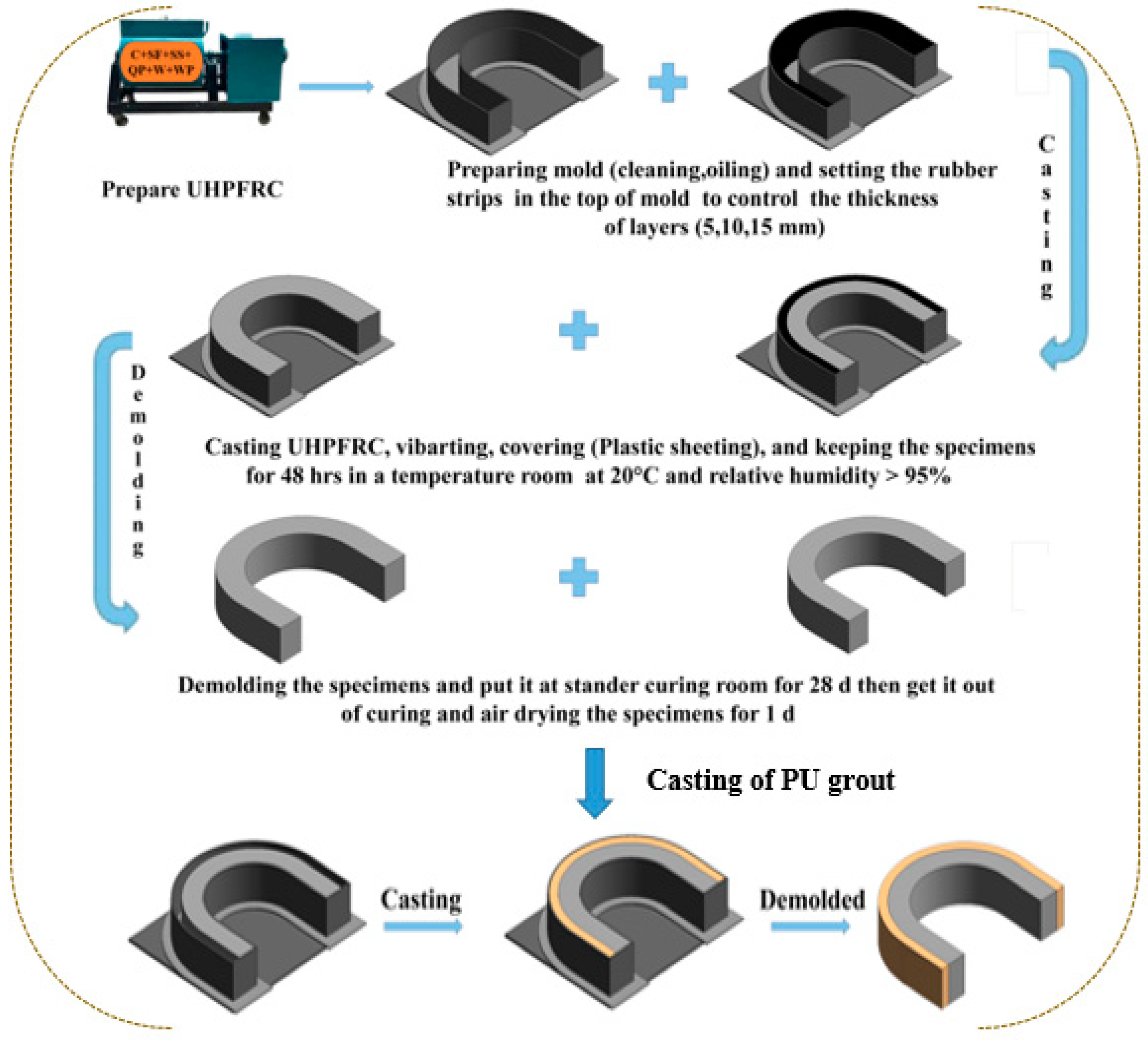
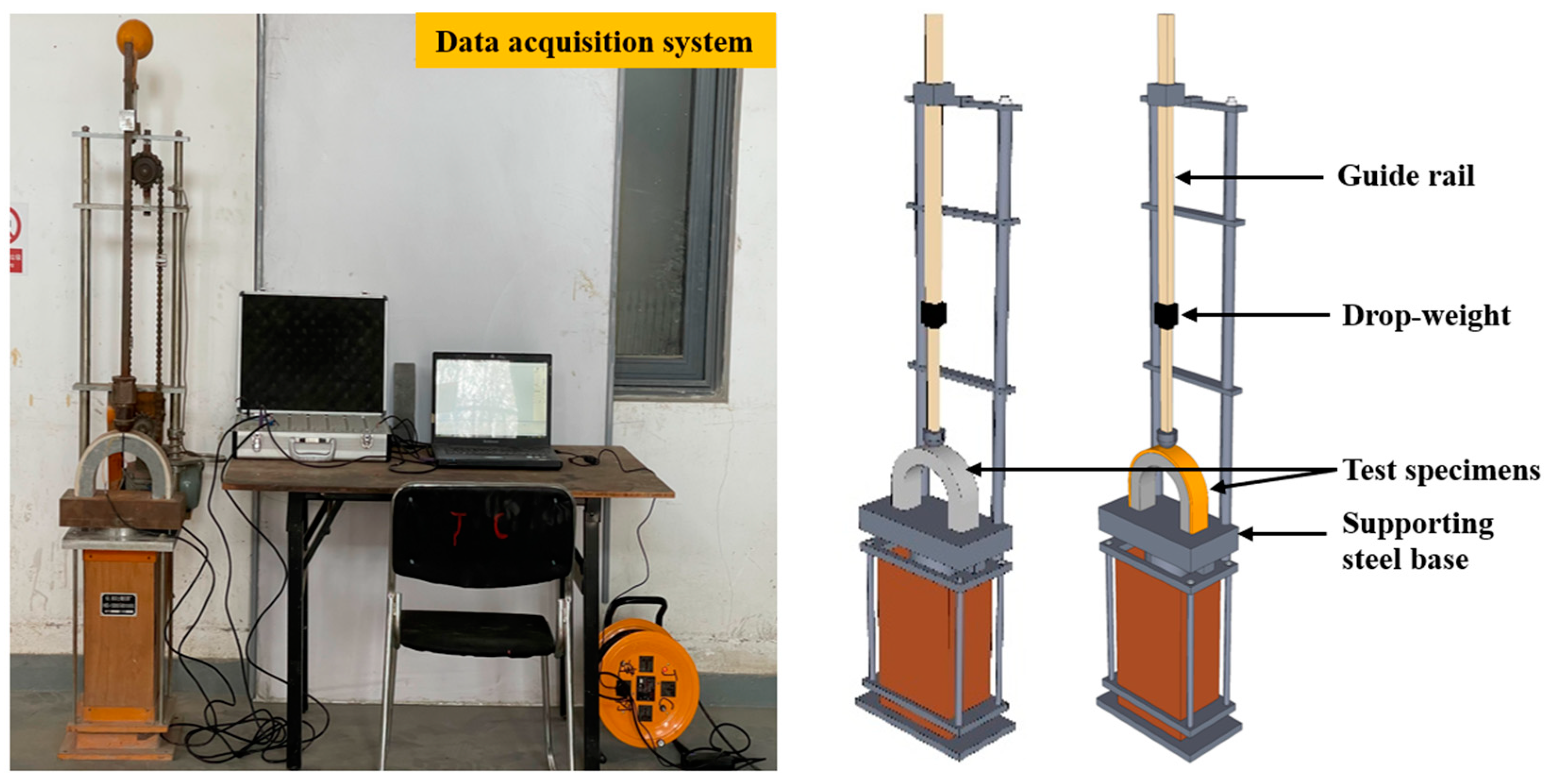
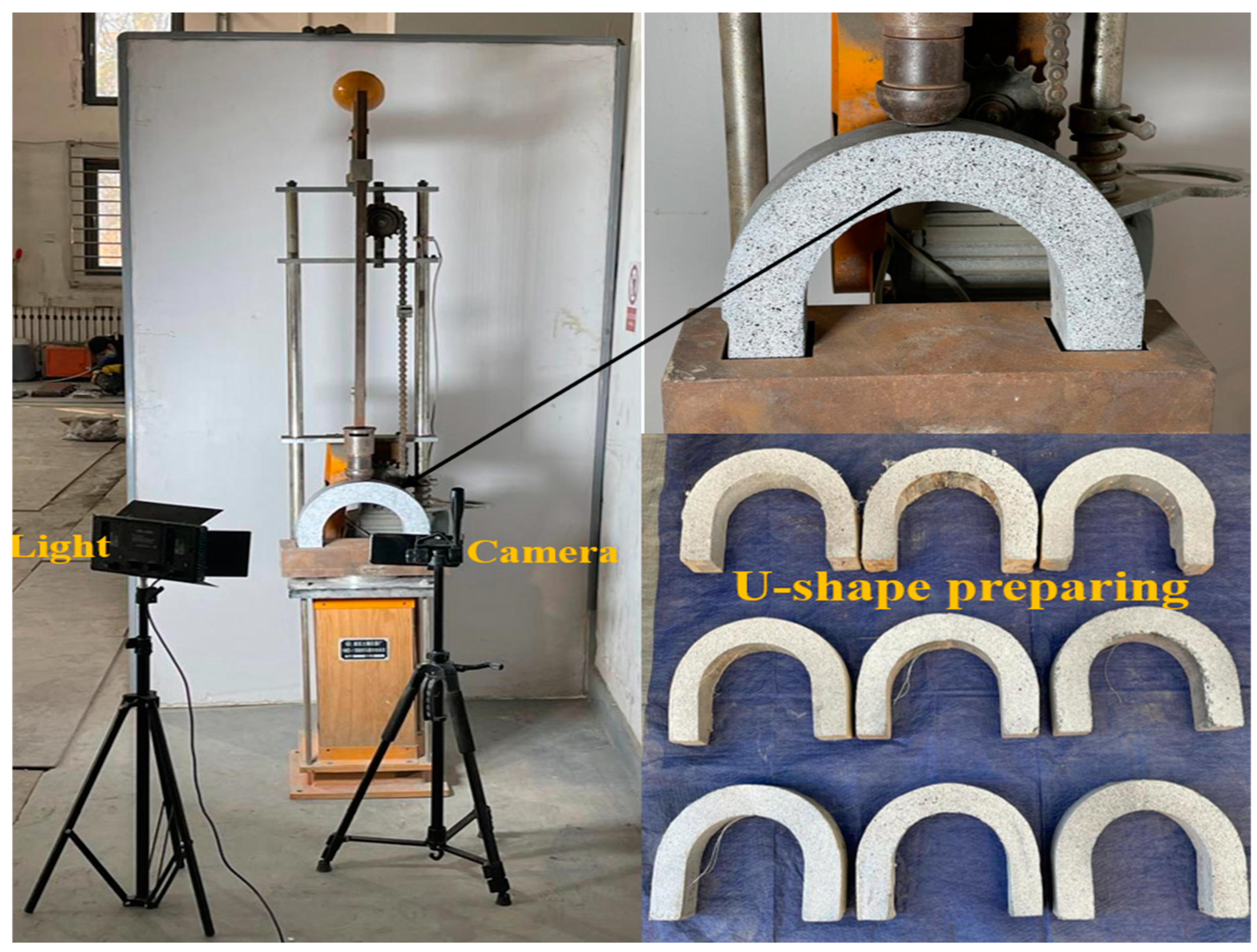
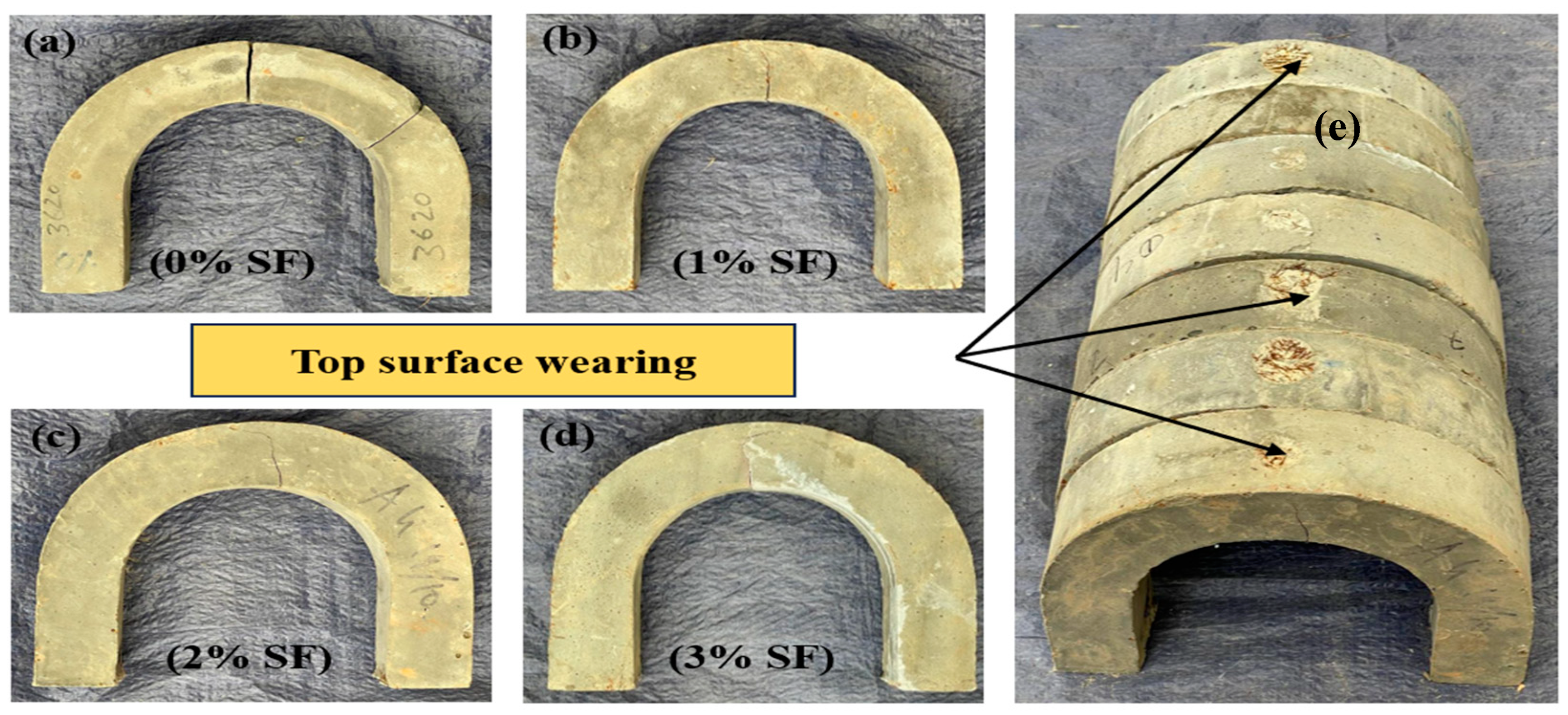
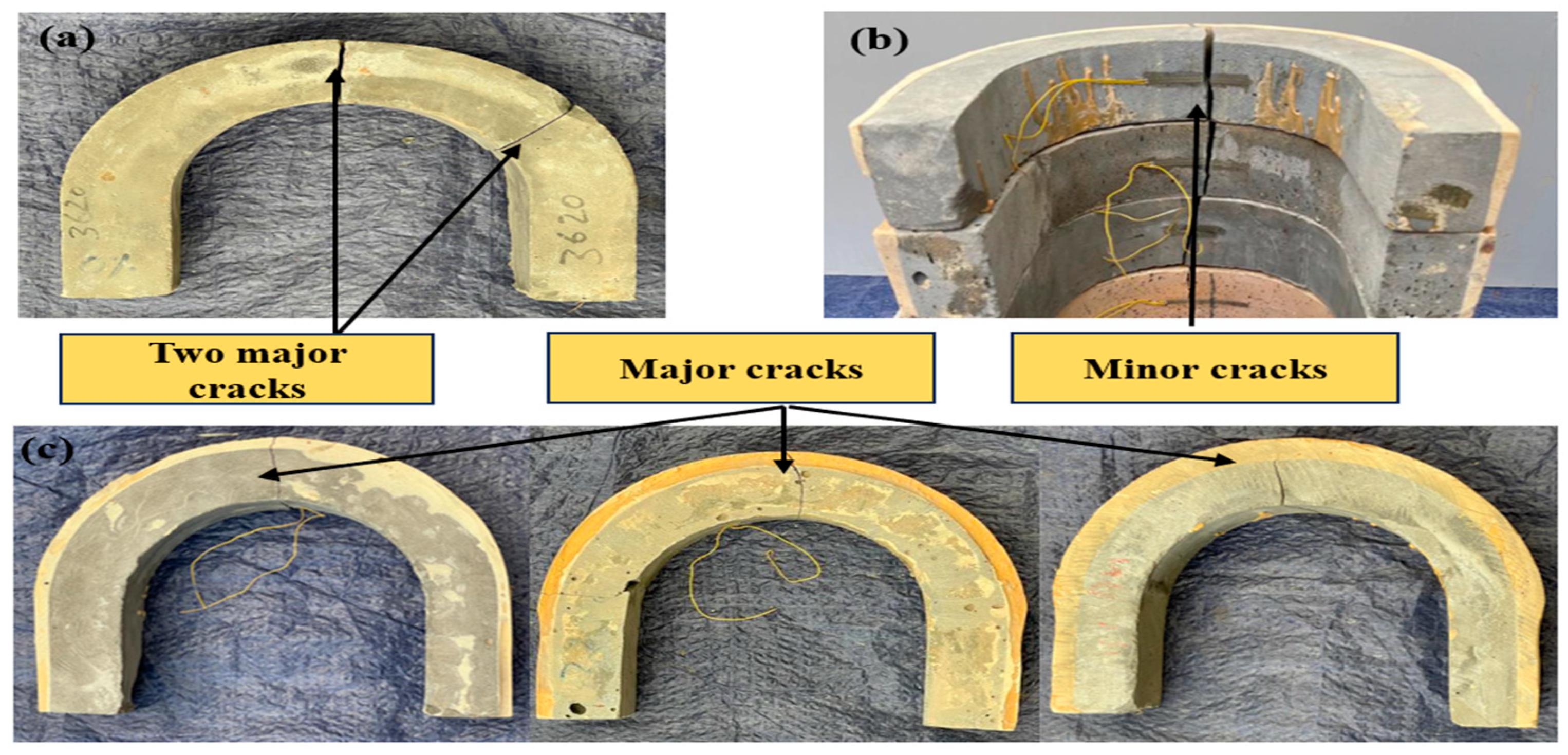
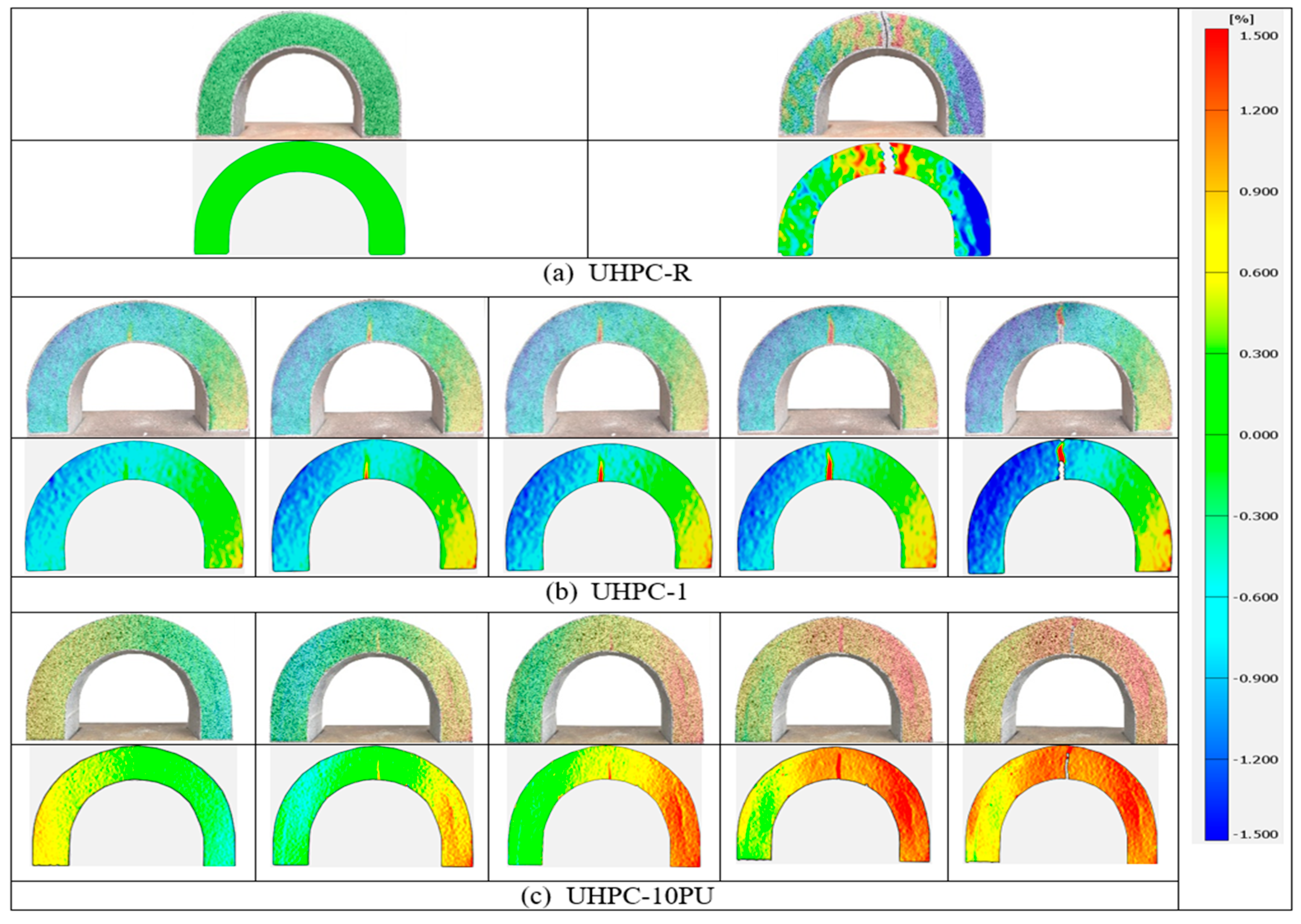
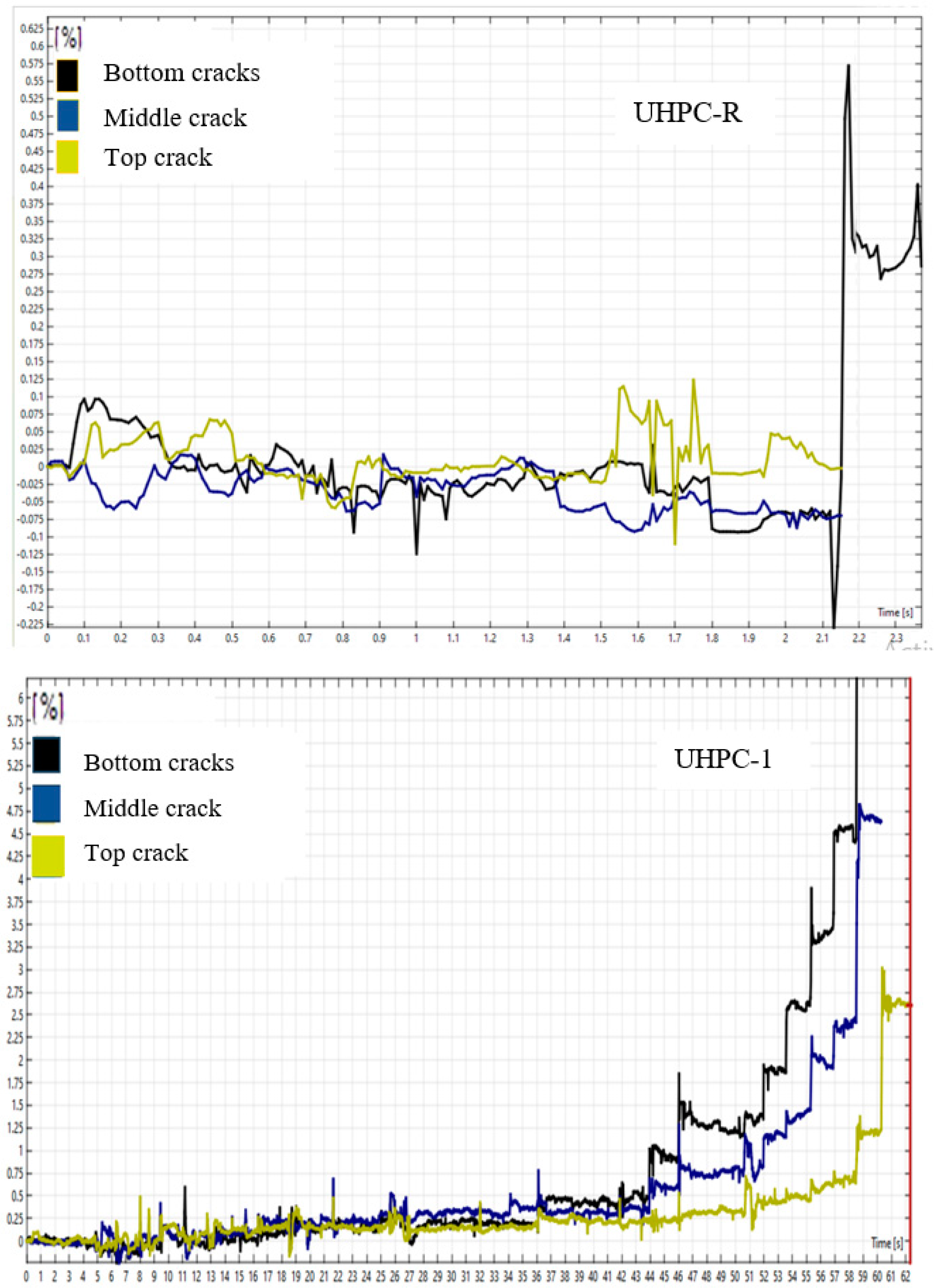
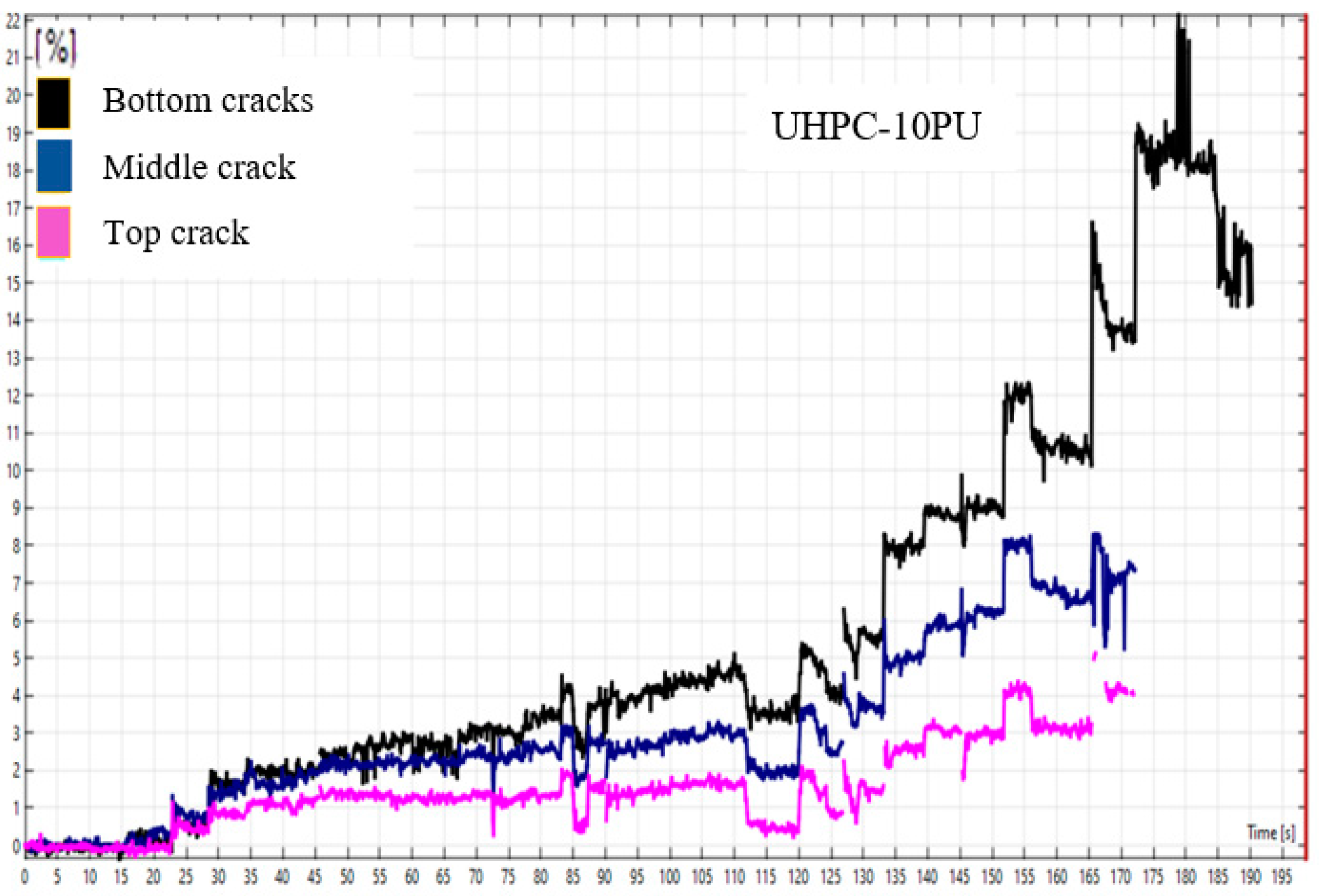
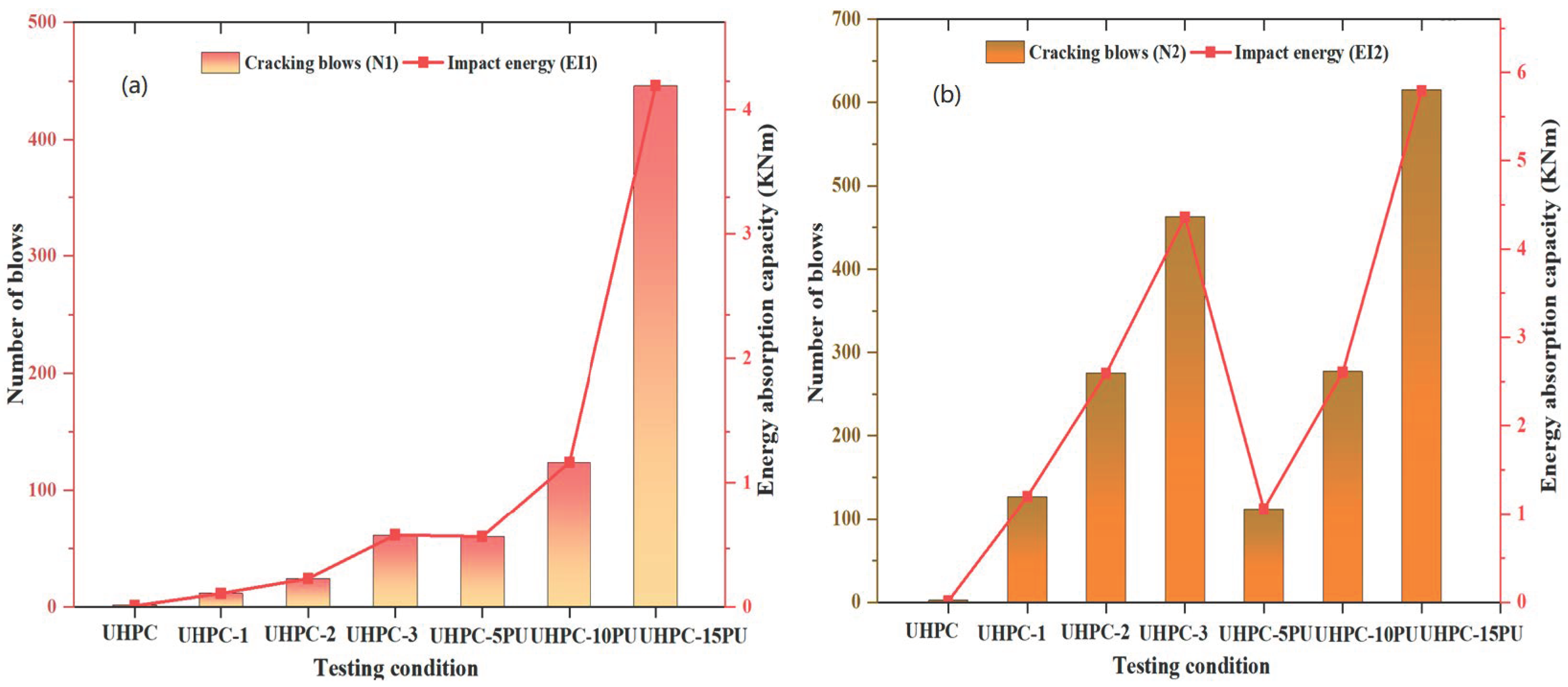
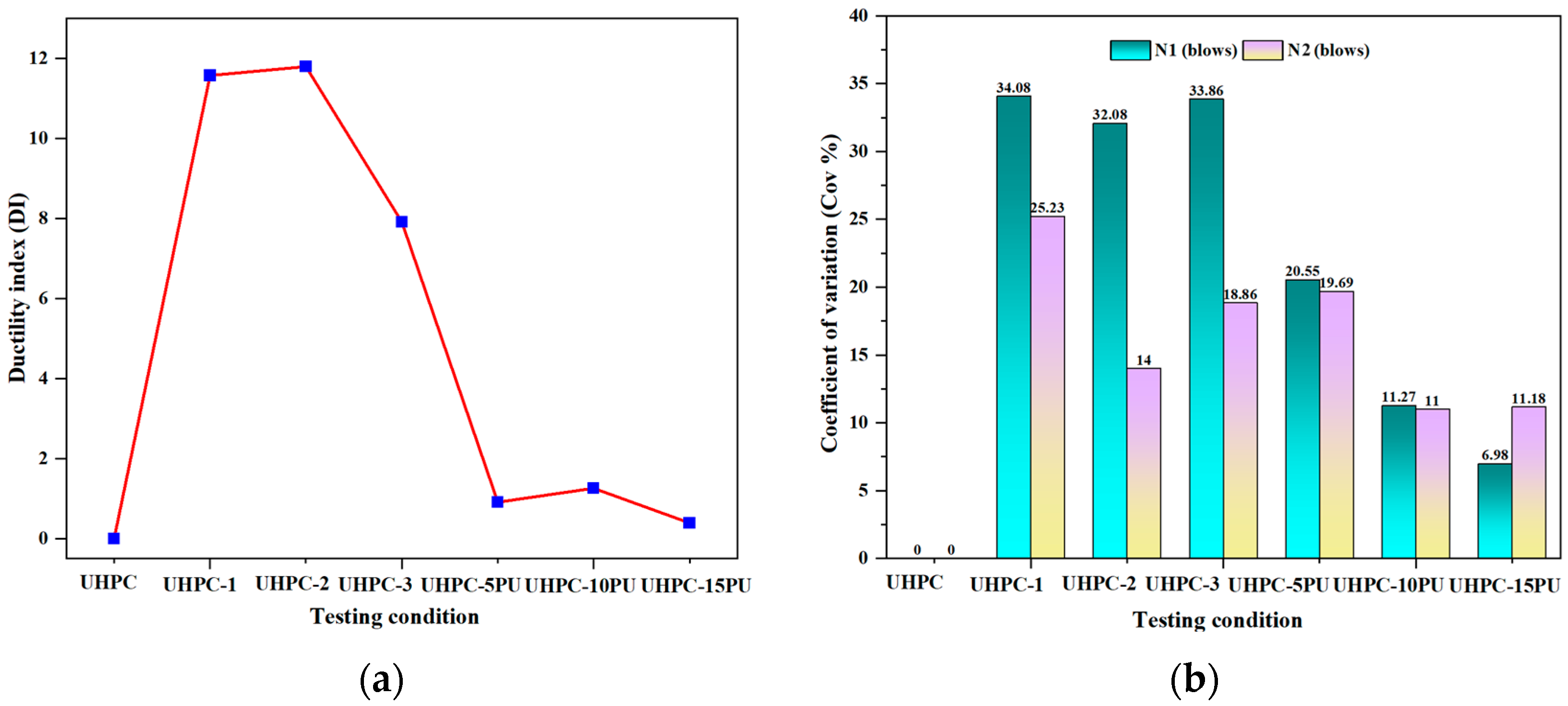
| Mixture ID | Cement | Silica Fume | Slag | Silica Sand | Quartz Powder | Water | SF (Vf%) | SP |
|---|---|---|---|---|---|---|---|---|
| UHPC-R | 1 | 0.25 | 0.2 | 1.2 | 0.05 | 0.232 | 0 | 0.2 |
| UHPC-1 | 1 | 0.25 | 0.2 | 1.2 | 0.05 | 0.232 | 1 | 0.2 |
| UHPC-2 | 1 | 0.25 | 0.2 | 1.2 | 0.05 | 0.232 | 2 | 0.2 |
| UHPC-3 | 1 | 0.25 | 0.2 | 1.2 | 0.05 | 0.232 | 3 | 0.2 |
| Specimen ID | PU Resin | Diluent (kg/m3) | |
|---|---|---|---|
| Polyol (kg/m3) | PAPI (kg/m3) | ||
| PU matrix | 362 | 60 | 7.2 |
| Mixture ID | N1 (Blows) | N2 (Blows) | (N2 − N1)/N1 | IE1 (N.mm2) | IE2 (N.mm2) |
|---|---|---|---|---|---|
| UHPC-R | 1 | 1 | 0 | 0.009 | 0.009 |
| UHPC-1 | 12 | 127 | 11.568 | 0.108 | 1.196 |
| UHPC-2 | 24 | 275 | 11.791 | 0.226 | 2.56 |
| UHPC-3 | 61 | 463 | 7.908 | 0.577 | 4.36 |
| UHPC-5PU | 60 | 112 | 0.91 | 0.564 | 1.054 |
| UHPC-10PU | 124 | 277 | 1.258 | 1.165 | 2.608 |
| UHPC-15PU | 446 | 616 | 0.39 | 4.194 | 5.789 |
Disclaimer/Publisher’s Note: The statements, opinions and data contained in all publications are solely those of the individual author(s) and contributor(s) and not of MDPI and/or the editor(s). MDPI and/or the editor(s) disclaim responsibility for any injury to people or property resulting from any ideas, methods, instructions or products referred to in the content. |
© 2024 by the authors. Licensee MDPI, Basel, Switzerland. This article is an open access article distributed under the terms and conditions of the Creative Commons Attribution (CC BY) license (https://creativecommons.org/licenses/by/4.0/).
Share and Cite
Al-shawafi, A.; Zhu, H.; Haruna, S.I.; Ibrahim, Y.E.; Luqsum, S.A. Enhanced Impact Strength of Ultra-High-Performance Concrete Using Steel Fiber and Polyurethane Grout Materials: A Comparative Study. Fibers 2024, 12, 77. https://doi.org/10.3390/fib12090077
Al-shawafi A, Zhu H, Haruna SI, Ibrahim YE, Luqsum SA. Enhanced Impact Strength of Ultra-High-Performance Concrete Using Steel Fiber and Polyurethane Grout Materials: A Comparative Study. Fibers. 2024; 12(9):77. https://doi.org/10.3390/fib12090077
Chicago/Turabian StyleAl-shawafi, Ali, Han Zhu, S. I. Haruna, Yasser E. Ibrahim, and Saleh Ahmed Luqsum. 2024. "Enhanced Impact Strength of Ultra-High-Performance Concrete Using Steel Fiber and Polyurethane Grout Materials: A Comparative Study" Fibers 12, no. 9: 77. https://doi.org/10.3390/fib12090077
APA StyleAl-shawafi, A., Zhu, H., Haruna, S. I., Ibrahim, Y. E., & Luqsum, S. A. (2024). Enhanced Impact Strength of Ultra-High-Performance Concrete Using Steel Fiber and Polyurethane Grout Materials: A Comparative Study. Fibers, 12(9), 77. https://doi.org/10.3390/fib12090077







